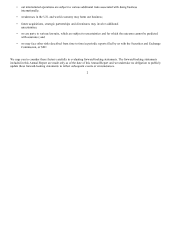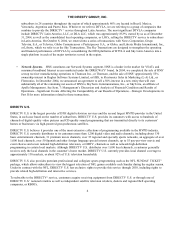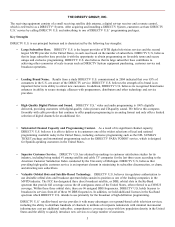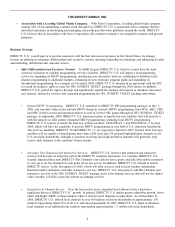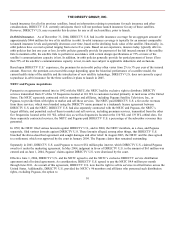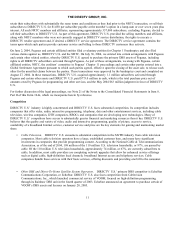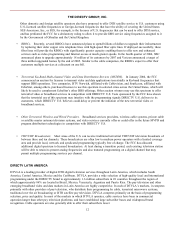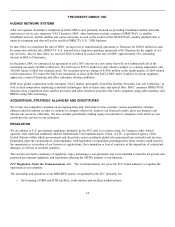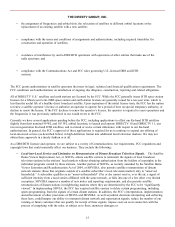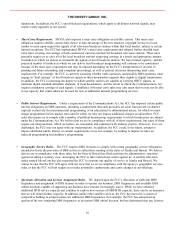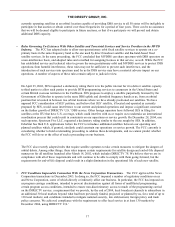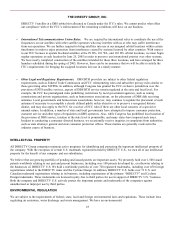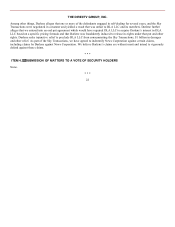DIRECTV 2004 Annual Report Download - page 21
Download and view the complete annual report
Please find page 21 of the 2004 DIRECTV annual report below. You can navigate through the pages in the report by either clicking on the pages listed below, or by using the keyword search tool below to find specific information within the annual report.
THE DIRECTV GROUP, INC.
Other domestic and foreign satellite operators also have proposed to offer DTH satellite service to U.S. customers using
U.S.-licensed satellite frequencies or foreign-licensed frequencies that have the ability of covering the United States.
SES Americom, Inc., or SES, for example, is the licensee of U.S. frequencies that can be used to offer DTH service,
and has petitioned the FCC for a declaratory ruling to allow it to provide DBS service using frequencies assigned to it
by the Government of Gibraltar and the United Kingdom.
•
RBOCs. Recently, several RBOCs have announced plans to spend billions of dollars to upgrade their infrastructure
by replacing their older copper wire telephone lines with high-speed fiber optic lines. If deployed successfully, these
fiber lines will provide the RBOCs with significantly greater capacity enabling them to offer new and enhanced
services such as video programming and Internet access at much greater speeds. In the fourth quarter of 2004, SBC
announced plans to upgrade approximately 18 million of its customers by 2007 and Verizon announced a target of
three million upgraded homes by the end of 2005. Similar to the cable companies, the RBOCs expect to offer their
customers multiple services at a discount on one bill.
•
Terrestrial Ku-Band Multi-channel Video and Data Distribution Services (MVDDS). In January 2004, the FCC
commenced an auction for licenses to transmit video and data applications terrestrially in Ku-band frequencies that
support DBS operations. Two companies, DTV Norwich, affiliated with Cablevision, and South.com, affiliated with
EchoStar, among others, purchased licenses to use this spectrum in selected cities across the United States, which will
likely be used to complement EchoStar’s other DBS offerings. Other auction winners may use this spectrum to offer
terrestrial video or broadband services in competition with DIRECTV U.S. Tests sponsored by the FCC have shown
that the terrestrial use of this spectrum may interfere with the programming signals DIRECTV U.S. delivers to its
customers, which DIRECTV U.S. believes could delay or prevent the initiation of the new terrestrial video or
broadband services.
•
Other Terrestrial Wireless and Wired Providers. Broadband services providers, wireless cable systems, private cable
or satellite master antenna television systems, and video services currently offer or could offer in the future MVPD and
program distribution technologies in competition with DIRECTV U.S.
•
VHF/UHF Broadcasters. Most areas of the U.S. can receive traditional terrestrial VHF/UHF television broadcasts of
between three and ten channels. These broadcasters are often low to medium power operators with a limited coverage
area and provide local, network and syndicated programming typically free of charge. The FCC has allocated
additional digital spectrum to licensed broadcasters. At least during a transition period, each existing television station
will be able to retain its present analog frequencies and also transmit programming on a digital channel that may
permit multiple programming services per channel.
DIRECTV LATIN AMERICA
DTVLA is a leading provider of digital DTH digital television services throughout Latin America, which includes South
America, Central America, Mexico and the Caribbean. DTVLA provides a wide selection of high-quality local and international
programming under the DIRECTV brand to approximately 1.6 million subscribers in 28 countries throughout the region of
which approximately 86% are located in Brazil, Mexico, Venezuela, Argentina and Puerto Rico. The pay television and other
emerging broadband video and data markets in Latin America are highly competitive. In each of DTVLA’s markets, it competes
primarily with other providers of pay television, who distribute their programming by cable, terrestrial microwave systems,
traditional over the air broadcasting or DTH satellite pay television. DTVLA competes primarily on the basis of programming
selection, price and quality. In most of the markets in which DTVLA operates, cable services have been in commercial
operation longer than other pay television platforms, and have established large subscriber bases and widespread brand
recognition. Cable operators are also generally able to offer their subscribers lower
12


